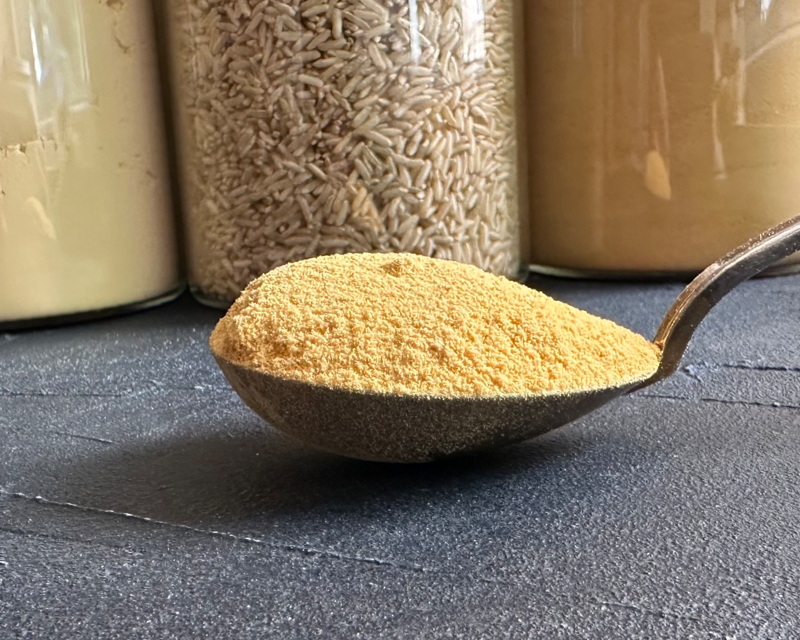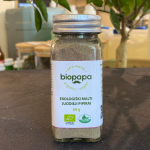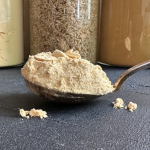Organic soya lecithin
From 1.90€
Organic soy lecithin
Organic soy lecithin is made from organic soybeans grown without synthetic pesticides or GMOs.
The resulting soya lecithin is carefully dried and packaged to preserve its organic integrity, making it a desirable ingredient for those who want emulsifiers and stabilisers from natural and sustainable sources.
Attention
Soya lecithin is derived from soya beans, so people with soya allergy should be cautious. Although most of the allergenic proteins are removed during processing, traces may remain.
Soya lecithin may interact with certain medicines, especially blood thinners such as warfarin. Be careful.
There is insufficient reliable information on whether lecithin is safe to use in higher amounts in pregnant or lactating women. Be careful.
Soya lecithin use
Food industry. Soya lecithin is a common ingredient in the food industry. It is used in products such as chocolate, baked goods, margarine and salad dressings to improve texture and extend shelf life.
Food supplements. Lecithin supplements are available in various forms, including capsules and granules. These supplements are used to improve brain function, support cardiovascular health and weight management.
Cosmetics and skin care. Soya lecithin is found in many skin care and cosmetic products due to its emollient properties. It helps maintain skin moisture by acting as a natural humectant.
In summary, soya lecithin is a versatile and widely used ingredient with many benefits and applications.
It is often added during baking to improve the texture of breads, cakes and pastries and retain moisture. It acts as an emulsifier for salad dressings and mayonnaise, ensuring that the oil and water components mix smoothly.
In Glotnuci, soya lecithin is useful for its ability to produce creamy, well-blended drinks.
It can be used to improve the consistency of sauces.
Due to its versatility, soya lecithin is a valuable addition to both sweet and savoury dishes, contributing to texture, taste and overall quality.
The recommended daily dose of soya lecithin powder is approximately 1-2 tablespoons, which is approximately 7-14 grams.
Homemade soy lecithin salad dressing recipe
Ingredients:
2 tablespoons soya lecithin powder
1/4 cup warm water
3 tablespoons organic extra virgin olive oil
2 tablespoons organic balsamic vinegar
1 clove of organic garlic or 1/4 tsp. garlic granules (optional)
1/2 teaspoon mustard
Salt and pepper to taste
Preparation:
In a small bowl, mix the soya lecithin powder with warm water. Stir well until the powder is completely dissolved. This may take a few minutes, so please be patient.
In a separate bowl, mix the organic extra virgin olive oil, balsamic vinegar, garlic (if using) and mustard.
Slowly pour the dissolved soya lecithin mixture into the bowl with the oil, vinegar and other ingredients. Continue whisking as you fill to ensure that the dressing emulsifies properly. Whisk until the sauce thickens and becomes creamy.
Season the sauce with salt and pepper.
You can also adjust the acidity or sweetness by adding more balsamic vinegar or a little honey if you like.
Season your sauce with herbs such as basil, thyme or oregano.
The zest of a citrus fruit (lemon, lime or orange) will add freshness to the sauce.
If you prefer a creamy sauce, you can add a spoonful of yoghurt or mayonnaise.
Your homemade soy lecithin salad dressing is ready to use!
Sources:
https://www.medicalnewstoday.com
https://www.verywellhealth.com
NOTE. The information contained herein should not be construed as a recommendation for treatment or other health issues. We encourage you to make personal decisions about your personal health, taking into account a wide range of sources of information.
Organic soya lecithin 100%
Energy value: 1500 kJ / 358 kcal
Fat: < 0.1 g
- of which saturates: < 0,1 g
Carbohydrates: < 0.5 g
- of which sugar: < 0,5 g
Fiber: 0,2 g
Protein: 96.0 g
Salt: 0,6 g
Store in a cool, dry place away from direct sunlight.





